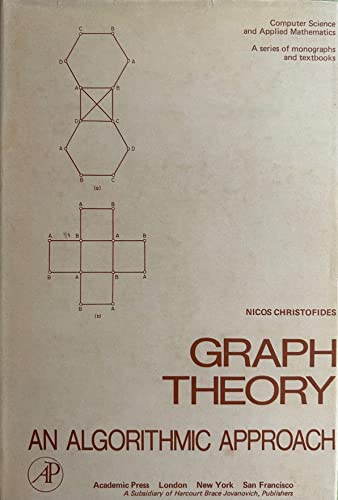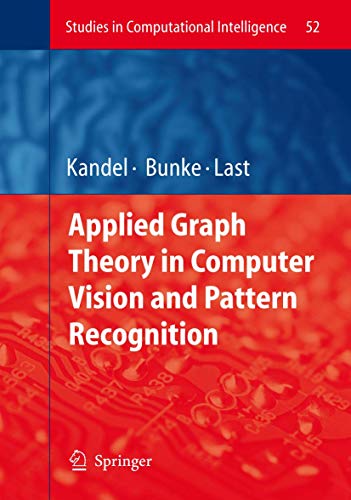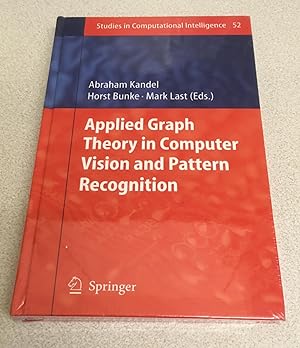Applied Graph Theory Computer (30 results)
Search filters
Product Type
- All Product Types
- Books (30)
- Magazines & Periodicals (No further results match this refinement)
- Comics (No further results match this refinement)
- Sheet Music (No further results match this refinement)
- Art, Prints & Posters (No further results match this refinement)
- Photographs (No further results match this refinement)
- Maps (No further results match this refinement)
- Manuscripts & Paper Collectibles (No further results match this refinement)
Condition Learn more
Binding
Collectible Attributes
- First Edition (1)
- Signed (No further results match this refinement)
- Dust Jacket (No further results match this refinement)
- Seller-Supplied Images (12)
- Not Print on Demand (22)
Language (2)
Free Shipping
Seller Location
Seller Rating
-
Graph Theory: An Algorithmic Approach (Computer Science and Applied Mathematics)
Seller: Anybook.com, Lincoln, United Kingdom
Condition: Fair. This is an ex-library book and may have the usual library/used-book markings inside.This book has hardback covers. In fair condition, suitable as a study copy. No dust jacket. Please note the Image in this listing is a stock photo and may not match the covers of the actual item,850grams, ISBN:0121743500.
-
Graph Theory: An Algorithmic Approach . Computer science and applied mathematics.
Published by Academic Press. 1975., 1975
Seller: Antiquariaat Ovidius, Bredevoort, Netherlands
Condition: Gebraucht / Used. Hardcover. Very good. Xv,400pp.
-
Applied Graph Theory in Computer Vision and Pattern Recognition (Studies in Computational Intelligence, 52)
Seller: HPB-Red, Dallas, TX, U.S.A.
hardcover. Condition: Good. Connecting readers with great books since 1972! Used textbooks may not include companion materials such as access codes, etc. May have some wear or writing/highlighting. We ship orders daily and Customer Service is our top priority!
-
Applied Graph Theory in Computer Vision and Pattern Recognition
Seller: GreatBookPrices, Columbia, MD, U.S.A.
Condition: New.
-
Condition: New.
-
Condition: New.
-
Applied Graph Theory in Computer Vision and Pattern Recognition (Studies in Computational Intelligence, 52)
Seller: Ria Christie Collections, Uxbridge, United Kingdom
US$ 127.92
US$ 15.81 shipping from United Kingdom to U.S.A.Quantity: Over 20 available
Add to basketCondition: New. In.
-
Condition: New.
-
Applied Graph Theory in Computer Vision and Pattern Recognition
Seller: GreatBookPricesUK, Woodford Green, United Kingdom
US$ 141.87
US$ 19.79 shipping from United Kingdom to U.S.A.Quantity: Over 20 available
Add to basketCondition: As New. Unread book in perfect condition.
-
Applied Graph Theory in Computer Vision and Pattern Recognition
Seller: GreatBookPricesUK, Woodford Green, United Kingdom
US$ 144.60
US$ 19.79 shipping from United Kingdom to U.S.A.Quantity: Over 20 available
Add to basketCondition: New.
-
Applied Graph Theory in Computer Vision and Pattern Recognition
Seller: Books Puddle, New York, NY, U.S.A.
Condition: New. pp. 276.
-
Applied Graph Theory in Computer Vision and Pattern Recognition
Seller: Books Puddle, New York, NY, U.S.A.
Condition: New. pp. 276.
-
Applied Graph Theory in Computer Vision and Pattern Recognition
Seller: Scarthin Books ABA, ILAB., Cromford, United Kingdom
First Edition
Book Hardcover. Condition: As New. No Jacket. 1st Edition. Springer, 2007. 1st Edition . As New/No Jacket. Book still in original shrink-wrap.
-
Applied Graph Theory in Computer Vision and Pattern Recognition
Seller: GreatBookPrices, Columbia, MD, U.S.A.
Condition: As New. Unread book in perfect condition.
-
Applied Graph Theory in Computer Vision and Pattern Recognition (Studies in Computational Intelligence)
Published by Springer Berlin Heidelberg, 2007
ISBN 10: 3642087647 ISBN 13: 9783642087646
Language: English
Seller: Revaluation Books, Exeter, United Kingdom
Paperback. Condition: Brand New. 276 pages. 9.25x6.10x0.63 inches. In Stock.
-
Taschenbuch. Condition: Neu. Applied Graph Theory in Computer Vision and Pattern Recognition | Abraham Kandel (u. a.) | Taschenbuch | x | Englisch | 2010 | Springer Vieweg | EAN 9783642087646 | Verantwortliche Person für die EU: Springer Verlag GmbH, Tiergartenstr. 17, 69121 Heidelberg, juergen[dot]hartmann[at]springer[dot]com | Anbieter: preigu.
-
Applied Graph Theory in Computer Vision and Pattern Recognition
Published by Springer Berlin Heidelberg, 2007
ISBN 10: 3540680195 ISBN 13: 9783540680192
Language: English
Seller: moluna, Greven, Germany
Gebunden. Condition: New. Will serve as a foundation for a variety of useful applications of the graph theory to computer vision, pattern recognition, and related areasCovers a representative set of novel graph-theoretic methods for complex computer vision and pattern reco.
-
Applied Graph Theory in Computer Vision and Pattern Recognition (Studies in Computational Intelligence, 52)
Seller: Ria Christie Collections, Uxbridge, United Kingdom
US$ 182.28
US$ 15.81 shipping from United Kingdom to U.S.A.Quantity: Over 20 available
Add to basketCondition: New. In.
-
Applied Graph Theory in Computer Vision and Pattern Recognition
Published by Springer Berlin Heidelberg, 2010
ISBN 10: 3642087647 ISBN 13: 9783642087646
Language: English
Seller: AHA-BUCH GmbH, Einbeck, Germany
Taschenbuch. Condition: Neu. Druck auf Anfrage Neuware - Printed after ordering - Graph theory has strong historical roots in mathematics, especially in topology. Its birth is usually associated with the 'four-color problem' posed by Francis Guthrie 1 in 1852, but its real origin probably goes back to the Seven Bridges of Konigsber g 2 problem proved by Leonhard Euler in 1736. A computational solution to these two completely different problems could be found after each problem was abstracted to the level of a graph model while ignoring such irrelevant details as country shapes or cross-river distances. In general, a graph is a nonempty set of points (vertices) and the most basic information preserved by any graph structure refers to adjacency relationships (edges) between some pairs of points. In the simplest graphs, edges do not have to hold any attributes, except their endpoints, but in more sophisticated graph structures, edges can be associated with a direction or assigned a label. Graph vertices can be labeled as well. A graph can be represented graphically as a drawing (vertex=dot,edge=arc),but,aslongaseverypairofadjacentpointsstaysconnected by the same edge, the graph vertices can be moved around on a drawing without changing the underlying graph structure. The expressive power of the graph models placing a special emphasis on c- nectivity between objects has made them the models of choice in chemistry, physics, biology, and other elds.
-
Applied Graph Theory in Computer Vision and Pattern Recognition
Published by Springer, Berlin, Springer Berlin Heidelberg, Springer, 2007
ISBN 10: 3540680195 ISBN 13: 9783540680192
Language: English
Seller: AHA-BUCH GmbH, Einbeck, Germany
Buch. Condition: Neu. Druck auf Anfrage Neuware - Printed after ordering - Graph theory has strong historical roots in mathematics, especially in topology. Its birth is usually associated with the 'four-color problem' posed by Francis Guthrie 1 in 1852, but its real origin probably goes back to the Seven Bridges of Konigsber g 2 problem proved by Leonhard Euler in 1736. A computational solution to these two completely different problems could be found after each problem was abstracted to the level of a graph model while ignoring such irrelevant details as country shapes or cross-river distances. In general, a graph is a nonempty set of points (vertices) and the most basic information preserved by any graph structure refers to adjacency relationships (edges) between some pairs of points. In the simplest graphs, edges do not have to hold any attributes, except their endpoints, but in more sophisticated graph structures, edges can be associated with a direction or assigned a label. Graph vertices can be labeled as well. A graph can be represented graphically as a drawing (vertex=dot,edge=arc),but,aslongaseverypairofadjacentpointsstaysconnected by the same edge, the graph vertices can be moved around on a drawing without changing the underlying graph structure. The expressive power of the graph models placing a special emphasis on c- nectivity between objects has made them the models of choice in chemistry, physics, biology, and other elds.
-
Applied Graph Theory in Computer Vision and Pattern Recognition (Studies in Computational Intelligence (52))
Seller: Mispah books, Redhill, SURRE, United Kingdom
Hardcover. Condition: Like New. Like New. book.
-
Applied Graph Theory in Computer Vision and Pattern Recognition (Studies in Computational Intelligence (52))
Seller: Mispah books, Redhill, SURRE, United Kingdom
Paperback. Condition: Like New. Like New. book.
-
Applied Graph Theory in Computer Vision and Pattern Recognition
Published by Springer, Berlin, Springer Berlin Heidelberg, Springer, 2007
ISBN 10: 3540680195 ISBN 13: 9783540680192
Language: English
Seller: BuchWeltWeit Ludwig Meier e.K., Bergisch Gladbach, Germany
Buch. Condition: Neu. This item is printed on demand - it takes 3-4 days longer - Neuware -Graph theory has strong historical roots in mathematics, especially in topology. Its birth is usually associated with the 'four-color problem' posed by Francis Guthrie 1 in 1852, but its real origin probably goes back to the Seven Bridges of Konigsber g 2 problem proved by Leonhard Euler in 1736. A computational solution to these two completely different problems could be found after each problem was abstracted to the level of a graph model while ignoring such irrelevant details as country shapes or cross-river distances. In general, a graph is a nonempty set of points (vertices) and the most basic information preserved by any graph structure refers to adjacency relationships (edges) between some pairs of points. In the simplest graphs, edges do not have to hold any attributes, except their endpoints, but in more sophisticated graph structures, edges can be associated with a direction or assigned a label. Graph vertices can be labeled as well. A graph can be represented graphically as a drawing (vertex=dot,edge=arc),but,aslongaseverypairofadjacentpointsst aysconnected by the same edge, the graph vertices can be moved around on a drawing without changing the underlying graph structure. The expressive power of the graph models placing a special emphasis on c- nectivity between objects has made them the models of choice in chemistry, physics, biology, and other elds. 266 pp. Englisch.
-
Applied Graph Theory in Computer Vision and Pattern Recognition
Published by Springer Berlin Heidelberg Nov 2010, 2010
ISBN 10: 3642087647 ISBN 13: 9783642087646
Language: English
Seller: BuchWeltWeit Ludwig Meier e.K., Bergisch Gladbach, Germany
Taschenbuch. Condition: Neu. This item is printed on demand - it takes 3-4 days longer - Neuware -This book presents novel graph-theoretic methods for complex computer vision and pattern recognition tasks. It presents the application of graph theory to low-level processing of digital images, presents graph-theoretic learning algorithms for high-level computer vision and pattern recognition applications, and provides detailed descriptions of several applications of graph-based methods to real-world pattern recognition tasks. 276 pp. Englisch.
-
Applied Graph Theory in Computer Vision and Pattern Recognition
Published by Springer Berlin Heidelberg, 2010
ISBN 10: 3642087647 ISBN 13: 9783642087646
Language: English
Seller: moluna, Greven, Germany
Condition: New. Dieser Artikel ist ein Print on Demand Artikel und wird nach Ihrer Bestellung fuer Sie gedruckt. Will serve as a foundation for a variety of useful applications of the graph theory to computer vision, pattern recognition, and related areasCovers a representative set of novel graph-theoretic methods for complex computer vision and pattern reco.
-
Applied Graph Theory in Computer Vision and Pattern Recognition
Seller: Majestic Books, Hounslow, United Kingdom
Condition: New. Print on Demand pp. 276 85 Illus.
-
Applied Graph Theory in Computer Vision and Pattern Recognition
Seller: Majestic Books, Hounslow, United Kingdom
Condition: New. Print on Demand pp. 276 Illus.
-
Applied Graph Theory in Computer Vision and Pattern Recognition
Seller: Biblios, Frankfurt am main, HESSE, Germany
Condition: New. PRINT ON DEMAND pp. 276.
-
Applied Graph Theory in Computer Vision and Pattern Recognition
Seller: Biblios, Frankfurt am main, HESSE, Germany
Condition: New. PRINT ON DEMAND pp. 276.
-
Applied Graph Theory in Computer Vision and Pattern Recognition
Published by Springer Berlin Heidelberg, Springer Berlin Heidelberg Nov 2010, 2010
ISBN 10: 3642087647 ISBN 13: 9783642087646
Language: English
Seller: buchversandmimpf2000, Emtmannsberg, BAYE, Germany
Taschenbuch. Condition: Neu. This item is printed on demand - Print on Demand Titel. Neuware -Graph theory has strong historical roots in mathematics, especially in topology. Its birth is usually associated with the ¿four-color problem¿ posed by Francis Guthrie 1 in 1852, but its real origin probably goes back to the Seven Bridges of Konigsber ¿ g 2 problem proved by Leonhard Euler in 1736. A computational solution to these two completely different problems could be found after each problem was abstracted to the level of a graph model while ignoring such irrelevant details as country shapes or cross-river distances. In general, a graph is a nonempty set of points (vertices) and the most basic information preserved by any graph structure refers to adjacency relationships (edges) between some pairs of points. In the simplest graphs, edges do not have to hold any attributes, except their endpoints, but in more sophisticated graph structures, edges can be associated with a direction or assigned a label. Graph vertices can be labeled as well. A graph can be represented graphically as a drawing (vertex=dot,edge=arc),but,aslongaseverypairofadjacentpointsstay sconnected by the same edge, the graph vertices can be moved around on a drawing without changing the underlying graph structure. The expressive power of the graph models placing a special emphasis on c- nectivity between objects has made them the models of choice in chemistry, physics, biology, and other elds.Springer Verlag GmbH, Tiergartenstr. 17, 69121 Heidelberg 276 pp. Englisch.

















